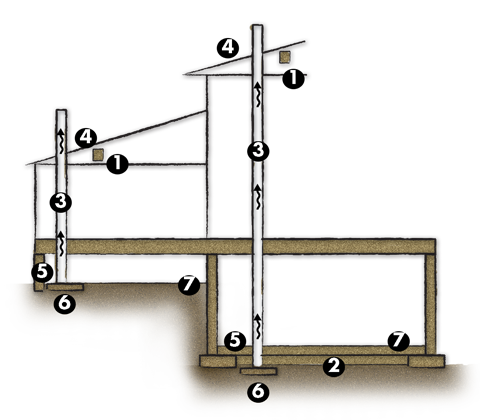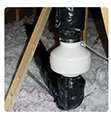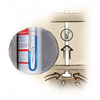Radon
- Radon in Homes
- Radon Testing
- Radon in Real Estate
- Find a Radon Measurement Professional
- Find a Radon Mitigation Professional
- Radon Mitigation Systems
- Financial Assistance
- Radon Resistant New Construction
- Licensing for Radon Professionals
- Radon Licensing System
- Laws, Rules and Standards
- Radon Poster Contest
Related Topics
Environmental Health Division
Radon Resistant New Construction
Since 2009, all new homes are required to be built radon-resistant. Home builders must use material and techniques to help prevent radon from entering the home. This includes sealing radon entry points and installing a vent pipe, but it does not include a fan. Instead, this passive radon system relies on the natural upward flow of air to exhaust radon through the pipe.
The radon system will become an active system with the installation of a fan. An active system is better at removing radon than a passive system. An active system may have the added benefit of decreasing moisture and soil vapors that may be present. Ask your builder about adding a fan to your passive radon system during construction. MDH no longer maintains a listing of builders that offer active radon systems, but many builders continue to take an active role in reducing the radon levels in the homes that they build
Features of passive radon-resistant construction

- Electrical junction box - An electrical junction box is roughed in the attic near the vent pipe. This power supply will be ready to use if the radon control system needs to be "activated" in the future.
- Aggregate - Four inches of clean aggregate is spread under all areas within the home's walls that will be covered by concrete slabs. Soil-gas collection mats or drainage mats can also be used.
- Vent pipe - The vent pipe runs vertically through the roof, directing the soil gases to the outdoors. The vent pipe is a 3 to 4 inch diameter PVC pipe that is connected to the "T" in the aggregate. If the home has a sump pit or drain-tile system, the vent pipe can be inserted directly into the sump pit or connected to the drain-tile loop.
- Roof flashing - Flashing must be installed around the vent pipe where it exits the roof to prevent leakage.
- Sealing - All potential soil gas entry points are sealed with caulk or expanding foam. Sump baskets must have sealed cover.
- Vent pipe "T" - A "T" fitting made of 3 to 4 inch diameter PVC pipe is inserted into the aggregate under the basement slab or under a crawl space's vapor barrier. The "T" pipe allows soil gases to enter with little resistance and connects to the main vent pipe.
- Soil-gas retarder - To help keep water/moisture in concrete so that it fully cures with minimum cracking. Six mil thick polyethylene sheeting, over lapped 12 inches at the seams, and fitted closely around all penetrations is placed over the aggregate. In crawl spaces, the sheeting is sealed to the foundation walls and interior piers.
Active system vs Passive system
Homes built with an active system are required to have:
- All passive radon system features. This includes a vent pipe that travels from below the foundation through the roof. It also includes sealing of openings, joints and penetrations in the foundation.
- A fan installed in an unconditioned space like an attic.
- A device to monitor whether the fan is working.
- An electrical outlet installed near the radon pipe.
What does it cost to operate an active system?
On the average, a radon reduction system costs slightly more than $14 per year to operate - just a fraction of what it costs to run a home computer, at more than $78 annually.
It may help control basement moisture
One common source of basement moisture, the entry of water vapor through the slab, may also be reduced by radon-resistant techniques. Therefore, a radon-resistant home may have less basement moisture than if it had been built without these features.
What should I do if the radon level in my new home is high?
If unacceptable radon levels are present, and the home has a passive radon system in place, it can be upgraded to an active system by adding and activating an in-line radon fan. Typically a monitor device is also installed with an active system.
 | In-line Radon Fan - The fan is wired into the electrical junction box that was roughed in or plugged into a nearby electrical outlet. This pulls radon and other soil gases from beneath the home and exhausts them to the outdoors. |
 | Monitor Device - A system failure warning device should also be installed to alert you if the system malfunctions. The most common warning device is a u-tube manometer. A u-tube manometer visually indicates whether or not the fan is running. |